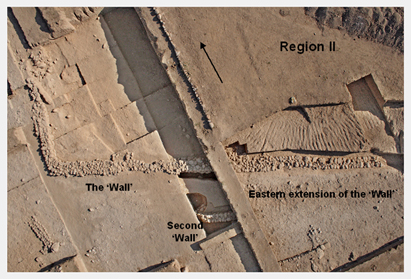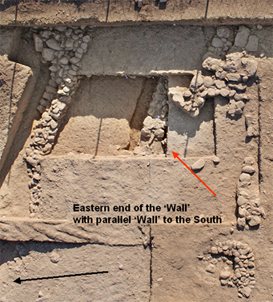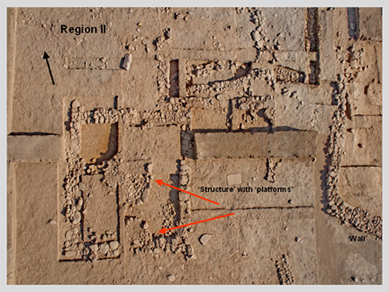
LEFKANDI-XEROPOLIS 2007 SEASON- Region II
Areas S and R
The ‘Wall’ and its Eastern extension
The focus here was to continue the work of the 2006 excavation. First we opened a test trench (2 m wide, and a good 15 m long) running North/South of the east baulk in Area R. The aim here was to investigate both the zones to the north and to the south of the ‘Wall’ (consisting of Walls 118/152 and 121).
 |
In Area S (to the east) we have now traced the ‘Wall’ for some more 20 m. The ‘Wall’ runs in a very straight line (allowing for local slippage to the north). In places it appears to be eroded away but in others survives high. At its eastern end (where we can still trace it within the land we owned), a stone-complex was found projecting to the north; it could be part of a bastion. The excavation here has not been completed and more work is required in order to understand the function of the structure and its relation to the ‘Wall’. Similar, projections have been noted in connection with the ‘Wall-line’ to the south. The sequences of soils south of the ‘Wall’ (Walls118/152) and at the east end of Area S, copy those seen in Area R.
 |
But another surprise was waiting to be revealed during the last week of digging. To the south and within the LH IIIC metalling spreads, we discovered another ‘Wall’ (Wall 161). This ‘Wall’ is of good quality but of a different construction style to Wall 118. It runs parallel to it some 3 m to its south. Wall 161 too has various stages of repair/rebuild, as well as perhaps an even earlier version just to its north. Only a small part of it was uncovered this year.
To test whether this second ‘Wall’ was also to be found in Area S, we calculated where it might be in relation to the extension of the ‘Wall’ there. During the last days of the excavation, Wall 177 was found at the extreme East end of Area S in exactly the position we expected it to be.
Thus it appears that there were in fact two ‘Walls’ marking the unusual profile at the north side of Xeropolis in this central region. This supports the earlier suggestion that some sort of major and long term civic engineering project was undertaken in this part of the settlement which might have been actually the main approach to it from the mainland in the north (see earlier reports in 2005 and 2006).
Area T
The ‘Structures’ to the West of the ‘Wall’
This area to the west of the ‘Wall’ was opened for investigation and to reveal further a strange ‘structure’ which was found at the North/West corner of Area R in 2006. At the time, the structure looked like a vertical kerb or edging made of sherds and small stones.
The 2007 excavation of the North/West corner revealed more of the curious ‘Structure’ mentioned above. First the size of it has increased, and we were able to expose its east and south sides while the other two are yet to be unearthed. What is extremely unusual about this particular ‘Structure’ is its method of construction: first something of a stone socle was laid. It appears that care was taken primarily in the construction of its interior face, where large rounded cobbles were set in a neat row, with smaller ones packed in behind. Then, the 'exterior' face was lined with both large rounded cobbles set vertically while smaller stones were placed behind to create an even surface. The result was to build an almost vertical exterior face (up to 40 cm in height). The vertical sherds and stones which were noticed in 2006 appear now to have been set in a second phase of its use. The technique of construction is unique at Lefkandi and elsewhere.
More excavation is needed here to reveal the rest of the ‘Structure’ in order to understand whether this was part of a building or of an unusual construction whose plan and function it is not possible to reconstruct before the completion of the excavation. The date of the structure is also not yet clear though its use lies within the LH IIIC and/or the beginning of the Early Iron Age.
Further to the west important discoveries were made this year. Another ‘Structure’ was found some 4 m square in size. The walls show at least two phases and were built with both small and flat stones and larger ones. The entrance of the ‘Structure’ was at the east side marked by flat slabs. The fill - of which only the later phase has been excavated - is, apart from some lumps, free of mudbricks. If this is the case for the rest of the fill not so far excavated, then it is possible that the structure was made of a low wall only and did not have a roof.
 |
A remarkable feature of this ‘Structure’ is the discovery of a number of circular ‘platforms’ found within it and roughly on its central North/South axis. The largest one is some 2 m across, the smallest less than half that size. Another ‘platform’, even smaller in size was found against and partly built into the south wall of the ‘Structure’. The method of construction is that of a circular kerb of large rounded stones enclosing flat slabs. Over this construction, a layer of smaller pebbles and stones was found covering most of the circular outline of the ‘platforms’. The ‘platforms’ can be compared to a similar construction found in the East Room of the Toumba Building (Lefkandi II.2, pl. 7).
The soils within the ‘Structure’ and around the ‘platforms’ have not been found to contain much bone or any domestic debris. Nor is there any trace of ash. On the contrary, vase fragments are plentiful, especially outside the ‘Structure’ and in the nearby area. The most popular shape is the crater (one example datable to the Sub-Mycenaean or to the Early Protogeometric periods has a diameter of roughly 70 cm). Inside the ‘Structure’, a fair number of spindle-whorls and conical buttons were retrieved. An exceptional item is a small steatite pendant, of anthropoid form with incised decoration. Similar pendants were found last year and another was reported in the 1960s excavations. Most of the pottery from the ‘Structure’ and the surrounding area appears to belong to the early phase of the Protogeometric period (roughly end of the eleventh and early tenth centuries).
Finally we can briefly mention here that between the area of the earlier ‘Structure’ with the unusual method of construction found to the North/West of the ‘Wall’ and the ‘Structure’ with the platforms further to the west, we discovered a series of ‘enclosures’ dated to several phases. The excavation here is not completed and thus it is not possible to report their definite plan and function. The dates of those excavated so far range from the LH IIIC to the Protogeometric period.
Home > New Excavations >2007 Season > 2007 Season Region II> 2008 Season
Copyright © 2009, http://lefkandi.classics.ox.ac.uk/
Any reproduction without expressed written consent is strictly prohibited